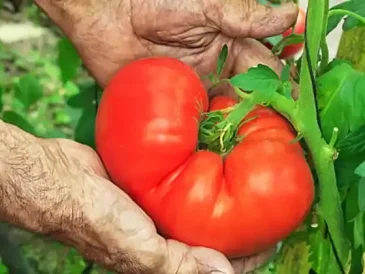Caring for hanging tomato plants is a smart and attractive method to grow these versatile fruits. It saves space, lowers the chances of soil-related diseases, and helps keep pests away. Here’s a detailed guide on how to care for your hanging tomato garden, guaranteeing a plentiful harvest.
1. Choosing the Right Variety

Select tomato varieties that are well-suited for hanging baskets. Dwarf or bush types, such as ‘Tumbling Tom’ and ‘Cherry Cascade,’ are ideal because of their compact growth habit and resistance to sprawling. These varieties are bred to thrive in confined spaces and will produce an abundant yield without the need for staking or pruning.
2. Selecting the Container
A suitable container is vital for the success of hanging tomato plants. Opt for baskets that are at least 12 to 14 inches in diameter to provide ample space for root growth. Ensure the container has sufficient drainage holes to prevent waterlogging, which can lead to root rot.
3. Using the Right Soil Mix
Fill your container with a high-quality potting mix designed for vegetables. These mixes are formulated to retain moisture while allowing proper drainage. Consider adding a slow-release fertilizer to the mix to provide a steady supply of nutrients throughout the growing season.
4. Planting Your Tomatoes
When planting, gently tease out the tomato plant’s roots to encourage them to spread out. Plant the tomato deeply in the soil, up to the first set of leaves, to promote strong root development. If you’re planting more than one tomato plant per container, space them at least 8 inches apart to ensure adequate air circulation.
5. Positioning Your Hanging Basket

Place your hanging tomato plant in a location where it will receive at least 6 to 8 hours of direct sunlight daily. Adequate sunlight is crucial for fruit production. Rotate the basket weekly to ensure all sides of the plant receive equal light exposure.
6. Watering Requirements
Tomato plants in hanging baskets dry out more quickly than those in the ground. Check the soil moisture daily, and water the plants thoroughly whenever the top inch of soil feels dry to the touch. In hot weather, this may mean watering twice a day. Use a watering can with a long spout to target the water directly to the soil, avoiding the leaves.
7. Feeding Your Plants
Feed your hanging tomato plants with a liquid tomato fertilizer every two weeks. This will replenish nutrients washed away by frequent watering and support healthy growth and fruiting.
8. Monitoring for Pests and Diseases
Regularly inspect your plants for signs of pests or disease. Common issues include aphids, whiteflies, and tomato blight. Early detection is key to managing these problems. Use organic pesticides or natural remedies, such as neem oil, to treat infestations without harming beneficial insects.
9. Harvesting
Tomatoes are ready to harvest when they are firm and fully colored. Gently twist the fruit off the vine to avoid damaging the plant. Regular harvesting encourages the plant to produce more fruit.

Recipe: Fresh Hanging Tomato Salsa
Once you’ve harvested your tomatoes, why not celebrate with a delicious, fresh salsa? Here’s a simple recipe to get you started:
Ingredients:
- 2 cups of freshly picked cherry tomatoes, halved
- 1 small onion, finely chopped
- 1 jalapeno pepper, seeded and minced
- 2 tablespoons of fresh cilantro, chopped
- Juice of 1 lime
- Salt and pepper to taste
Instructions:
- In a medium bowl, combine the halved cherry tomatoes, chopped onion, minced jalapeno, and chopped cilantro.
- Squeeze the lime juice over the mixture and season with salt and pepper.
- Gently toss the ingredients together until well mixed.
- Let the salsa sit for about 10 minutes to allow the flavors to meld.
- Serve with tortilla chips or as a fresh topping for grilled chicken or fish.

This guide and recipe provide a comprehensive approach to caring for hanging tomato plants and making the most of your harvest. Enjoy the process of growing and the fresh taste of home-grown tomatoes!




